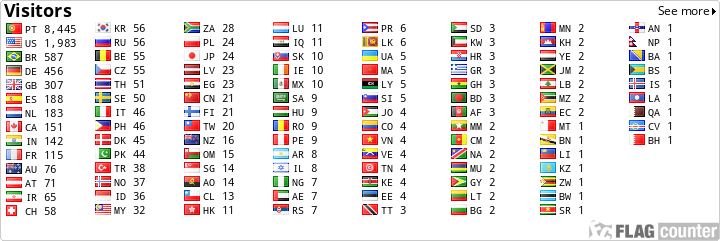From the guidelines, as from January 2013"People do not need to wait for permission to log your EarthCache. Requiring someone to wait is not supported by the EarthCache guidelines. People should send their logging task answers to you, then log your EarthCache. When you review their logging task answers, if there is a problem, you should contact them to resolve it. If there is no problem, then their log simply stands."

While fractures are the commonest expression of rock deformation, there can be no doubt that folds are the most spectacular (figure 1). The term fold is used in geology when one or a stack of originally flat and planar surfaces, such as sedimentary strata, are bent or curved as a result of plastic deformation and are the direct evidence of the existence of the tremendous forces which act upon the Earth's crust.
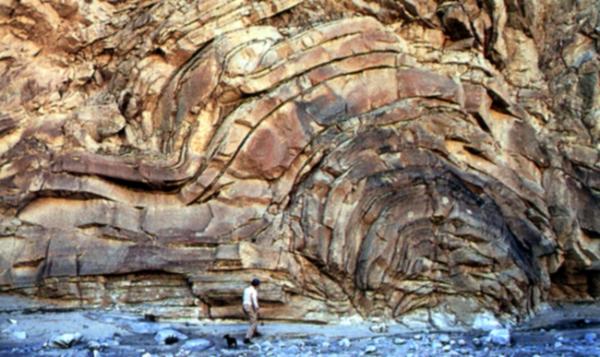
Now here's the part you don't like!
Basic fold geometry and nomenclature
Fold hinge and limbs - If we consider a single folded surface (figure 1) the main elements of the geometry of the fold shape are firstly the hinge or closure, which is the zone of maximum curvature 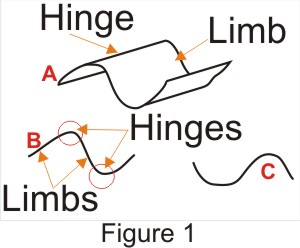 of the surface, and secondly the limbs, which are the areas between the hinges. If it is possible to define a line of maximum curvature, this line is called the hinge line. A single fold comprises a hinge and two limbs which enclose the hinge. In a series of folds, each limb is common to two adjacent folds. Depending on the actual shape of the fold, that is, on the way in which a surface changes curvature, the hinge may be very sharply defined and the limbs relatively straight (figure 1B), or the curvature may be more constant around the fold if it approaches a cylindrical shape (figure 1C). In a truly cylindrical fold, where the fold surface corresponds to part of the surface of a cylinder, neither hinge nor limb can be defined, but such examples are uncommon.
of the surface, and secondly the limbs, which are the areas between the hinges. If it is possible to define a line of maximum curvature, this line is called the hinge line. A single fold comprises a hinge and two limbs which enclose the hinge. In a series of folds, each limb is common to two adjacent folds. Depending on the actual shape of the fold, that is, on the way in which a surface changes curvature, the hinge may be very sharply defined and the limbs relatively straight (figure 1B), or the curvature may be more constant around the fold if it approaches a cylindrical shape (figure 1C). In a truly cylindrical fold, where the fold surface corresponds to part of the surface of a cylinder, neither hinge nor limb can be defined, but such examples are uncommon.
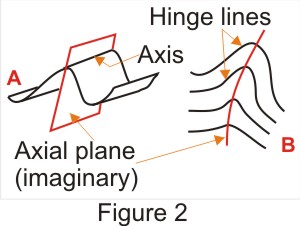 Fold axis and axial plane - In describing the attitude of a fold, it is useful to refer, not to the attitudes of both limbs, but to the imaginary plane which is equidistant from each limb and which bisects the angle between them. This plane is termed the axial plane and cuts the hinge zone of the fold along a line which is termed the fold axis (figure 2A). Provided that the limbs of a fold are sufficiently well defined, the determination of the orientation of axial plane and axis will give a precise description of the orientation of the fold. It must be remembered
Fold axis and axial plane - In describing the attitude of a fold, it is useful to refer, not to the attitudes of both limbs, but to the imaginary plane which is equidistant from each limb and which bisects the angle between them. This plane is termed the axial plane and cuts the hinge zone of the fold along a line which is termed the fold axis (figure 2A). Provided that the limbs of a fold are sufficiently well defined, the determination of the orientation of axial plane and axis will give a precise description of the orientation of the fold. It must be remembered 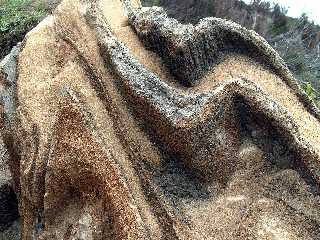 that these terms refer only to a single fold surface.
that these terms refer only to a single fold surface.
Fold axial surface - When we consider a fold consisting of a number of fold surfaces, it is usually more convenient to define a single surface such that it passes through the hinge lines of each successive fold surface. Such a surface is in general not planar and is known as the fold axial surface (figure 2B). The hinge lines are not always easy to locate by eye if the hinge zone is broad and the method is only appropriate for relatively tight folds with well defined hinges.
Inter-limb angle - The smaller angle made by the limbs of a fold is termed the inter-limb angle or fold angle. The tightness or openness of a fold as expressed by this angle is a· useful method of classifying folds (figure 3A) and reflects the intensity of deformation.
 Amplitude and wavelength - These are convenient measures of the size of a fold. The easiest method of determining the wavelength of a fold is to measure the distance between the hinges on either side of the fold. If these are not visible, the half-wavelength may be measured instead by taking the distance between the two inflexion points on either side of the fold hinge. The inflexion points are where the sense of curvature changes from one fold into the next (see figure 3B). The amplitude or "height" of a fold may be measured by taking half the perpendicular distance from the hinge to the line between the two adjoining hinges or the perpendicular distance from the hinge to the line between the two inflexion points.
Amplitude and wavelength - These are convenient measures of the size of a fold. The easiest method of determining the wavelength of a fold is to measure the distance between the hinges on either side of the fold. If these are not visible, the half-wavelength may be measured instead by taking the distance between the two inflexion points on either side of the fold hinge. The inflexion points are where the sense of curvature changes from one fold into the next (see figure 3B). The amplitude or "height" of a fold may be measured by taking half the perpendicular distance from the hinge to the line between the two adjoining hinges or the perpendicular distance from the hinge to the line between the two inflexion points.
Fold orientation
The orientation of a fold may be measured in the field by obtaining the attitudes of both limbs, and if the limbs are relatively straight and regular this information is sufficient for a complete 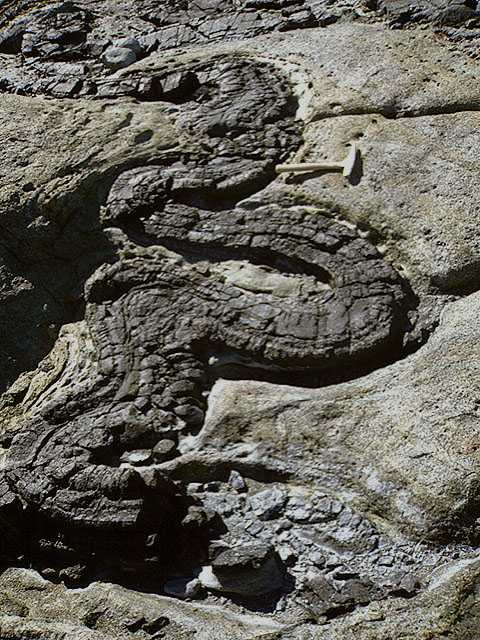 description of the fold attitude. However it is more convenient, and conveys more useful information, to describe and record folds in terms of their axial planes or surfaces, and axes. Thus on a map the position of a fold is shown by drawing the outcrop of the fold axial surface as a line. This line is termed the fold axial trace. The dip and strike of the axial plane or axial surface may also be plotted in the same way as for a bedding plane.
description of the fold attitude. However it is more convenient, and conveys more useful information, to describe and record folds in terms of their axial planes or surfaces, and axes. Thus on a map the position of a fold is shown by drawing the outcrop of the fold axial surface as a line. This line is termed the fold axial trace. The dip and strike of the axial plane or axial surface may also be plotted in the same way as for a bedding plane.
Fold plunge - The attitude of the fold axis is measured as the angle between the axis and the horizontal. This angle, which must be measured in a vertical plane (like the dip angle) is termed the plunge (figure 2.4), so that a complete description of the orientation of a fold axis is given as an amount and direction of plunge, for example, a fold plunges 30° towards (on a bearing of) 105°.
Classification of folds
The classification of folds is based on four main features or properties: (a) direction of closing, (b) attitude of axial surface, (c) size of inter-limb angle, and (d) nature of profile.
Closing and facing direction - Folds which close upwards, that is where the limbs dip away from the hinge, are termed antiforrns (figure 4A) and those which close downwards, where the limbs dip towards the hinge, are termed synforrns (figure 4B). Folds which close sideways are termed neutral folds (figure 4E). Under normal conditions where the bedding becomes younger upwards, an antiform will contain older rocks in its core and is then given the more familiar name anticline. Thus the term anticline should strictly be applied only to a fold with older rocks in its core (figure 4D). Conversely, a syncline is a fold which contains younger rocks in its core (figure 4E).
In areas of more complex folding, where strata are commonly  inverted, it is possible to find downward-closing anticlines or upward-closing synclines (figure 4F). In such areas it is convenient to speak of the facing direction of a fold, which is the direction along the axial surface in which the strata become younger. Thus in figure 4F, fold X is an anticlinal synform and fold Y is a synclinal antiform, and both folds face downwards since the strata are inverted. The main fold, W, with a sub-horizontal axial surface is a neutral fold, facing towards the left. Fold Z is an upward-facing (synclinal) synform.
inverted, it is possible to find downward-closing anticlines or upward-closing synclines (figure 4F). In such areas it is convenient to speak of the facing direction of a fold, which is the direction along the axial surface in which the strata become younger. Thus in figure 4F, fold X is an anticlinal synform and fold Y is a synclinal antiform, and both folds face downwards since the strata are inverted. The main fold, W, with a sub-horizontal axial surface is a neutral fold, facing towards the left. Fold Z is an upward-facing (synclinal) synform.
Attitude of axial plane - Folds may be divided into three groups based on the dip of the axial plane or surface. Folds with steep to vertical axial planes are termed upright, those with moderately-dipping axial planes are termed inclined and those with sub-horizontal axial planes are termed recumbent (figure 5A-D). The division between these classes is not rigidly defined. Inclined folds where one limb is inverted are termed overfolds (figure 5C). In inclined folds the highest and lowest points on the fold surface do not in general correspond with the hinges and it is sometimes useful to use the terms crest and trough respectively for these positions.
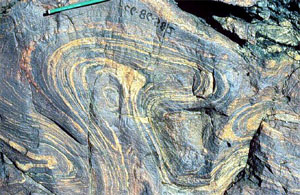
Inter-limb angle - The size of the inter-limb  angle measures the degree of tightness of a fold which reflects the amount of compression of the strata. Figure 3A shows a classification scheme which sub-divides folds into four classes: gentle (180°-120°), open (120°-70°), close (70°-30°), tight (30°-0°) and isoclinal (0°). These limits are not usually strictly adhered to. Precision is better achieved, if required, by stating the angle. Gentle folds are often termed flexures. Problems arise in measuring the fold angle where the limbs are not straight. In such a case tangents can be drawn to the curve at the point of inflexion (figure 3B). The inter-limb angle is the angle made by the two tangents.
angle measures the degree of tightness of a fold which reflects the amount of compression of the strata. Figure 3A shows a classification scheme which sub-divides folds into four classes: gentle (180°-120°), open (120°-70°), close (70°-30°), tight (30°-0°) and isoclinal (0°). These limits are not usually strictly adhered to. Precision is better achieved, if required, by stating the angle. Gentle folds are often termed flexures. Problems arise in measuring the fold angle where the limbs are not straight. In such a case tangents can be drawn to the curve at the point of inflexion (figure 3B). The inter-limb angle is the angle made by the two tangents.
Folds can furthermore be classified according to their profile- The fold profile is the shape of a folded layer observed in the plane perpendicular to the Fold axis. Folds exhibit considerable variation in profile, and since this variation partly reflects differences in the mechanism of formation a precise description of this profile is often very important. However, for the purpose of this earthcache, the above lesson will suffice.
 The cache:
The cache:
The coordinates will take you to a road cutting near Martinlongo in the Algarve. For best viewing of the structures, climb to the highest point and face ESE.
Your mission to claim this earthcache is to characterise the fold/s that you see at the designated coordinates (eg. fold 1- NE quadrant, close antiform plunging approximately 25º to the NW). Use the above definitions and general text to help you. Send me your results by mail for validation of your "found".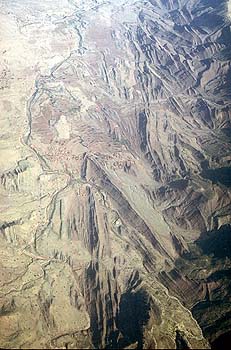 Have fun. Note: no photos of the outcrops in the logs even though the folds are spectacular.
Have fun. Note: no photos of the outcrops in the logs even though the folds are spectacular.

Enquanto que as fracturas geológicas são a forma mais comun da expressão da deformação das rochas, as dobras são seguramente as mais espectaculares (figura 1). O termo dobra é usado em geologia quando um ou mais estratos que eram originalmente planos se encontram curvados ou dobrados devido à deformação plástica das rochas. As dobras são a evidência clara das forças que actuam na crusta terrestre.
A tradução integral do texto supracitado não é necessária para poderem fazer o found desta cache. No entanto, e para vos ajudar, segue-se um pequeno glossário de auxílio.
Hinge = charneira (referido a um dobramento)
Axial plane = plano axial (de uma dobra)
Fold axial surface = superficie axial ( no caso de não ser obrigatóriamente planar)
Amplitude and wavelength = Amplitude e comprimento de onda da dobra
Limbs = Flancos da dobra
Plunge = mergulho (neste caso descreve-se o mergulho do eixo da dobra, ex. o eixo da dobra mergulha para SW a 32º)
Antiform = antiforma
Synform = Sinforma
A cache:
As coordenadas desta cache vão-vos levar a um corte de estrada perto de Martinlongo no Algarve. Para melhor puderem  observar as estruturas em questão é melhor subirem para o ponto mais alto e olhar, atentamente, para ESE.
observar as estruturas em questão é melhor subirem para o ponto mais alto e olhar, atentamente, para ESE.
A vossa missão consiste na caracterização das dobras que estão expostas no corte à vossa frente. Baseiem-se nas descrições e lição supracitada para descrever, o melhor possível, as dobras. A descrição deve conter os termos citados no glossário, ex. Dobra 1 - quadrante NW - antiforma fechado com eixo da dobra a mergulhar 25º para SSE. Usem os vossos melhores poderes de observação e avançem lá com a caracterização destas dobras espectaculares. Enviem um mail com as respostas para validar o found.
Peço-vos que não coloquem fotos do corte onde se possam ver as dobras de forma as que os mais preguiçosos não tenham de sair do sofá para as observar.

Note: all english text and technical figures adapted from: Park, R. G., 1983. Foundations of Structural Geology. Blackie, 135p.
Glossário verificado pelo Professor J. Brandão Silva da Faculdade de Ciências da Universidade de Lisboa a quem se agradeçe a amabilidade.
 The most exciting way to learn about the Earth and its processes is to get into the outdoors and experience it first-hand. Visiting an Earthcache is a great outdoor activity the whole family can enjoy. An Earthcache is a special place that people can visit to learn about a unique geoscience feature or aspect of our Earth. Earthcaches include a set of educational notes and the details about where to find the location (latitude and longitude). Visitors to Earthcaches can see how our planet has been shaped by geological processes, how we manage the resources and how scientists gather evidence to learn about the Earth. To find out more click HERE.
The most exciting way to learn about the Earth and its processes is to get into the outdoors and experience it first-hand. Visiting an Earthcache is a great outdoor activity the whole family can enjoy. An Earthcache is a special place that people can visit to learn about a unique geoscience feature or aspect of our Earth. Earthcaches include a set of educational notes and the details about where to find the location (latitude and longitude). Visitors to Earthcaches can see how our planet has been shaped by geological processes, how we manage the resources and how scientists gather evidence to learn about the Earth. To find out more click HERE.
______________________________________________________________________________

